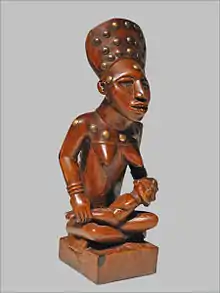


Phemba, also known as Yombe maternity figures, refers to sculptural objects that depict the figures of a mother and child.[1][2] Phemba are iconic examples of Kongo art and according to Thompson (1981) "reflect the degree to which women are treasured in Kongo culture, not just for their fecundity, but as seers and guardians of the spirit".[3] Kongo societies are matrilineal.[4]
In special cases, communities honored women by commissioning stone icons depicting a mother and child to be placed on their tombs. This was also considered dangerous, as it represented an insertion of the source of life - the mother - into the world of the dead.[3]
The Kikongo word phemba translates to "the white",[5] in reference to the white earth (Kaolinite) that is a sign of fertility in the region. The name is interpreted by John M. Janzen (1979) as denoting "'the one who gives children in-potentia.' A phemba child is a magically conceived nkisi child, a fragile emissary of the spirit world."[6]
Phemba statuary falls into two groups: mothers cradling or holding their babies, and mothers nursing.[3] The very different styles of phemba sculptures illustrate regional and even personal variations on the same theme.
See also
References
- ↑ Masterpieces of the People's Republic of the Congo: the African-American Institute, September 25, 1980-January 24, 1981. African-American Institute. 1980. p. 6. Retrieved 28 May 2013.
- ↑ Phyllis Martin (2009). Catholic women of Congo-Brazzaville: mothers and sisters in troubled times. Indiana University Press. pp. 197–. ISBN 978-0-253-22055-4. Retrieved 28 May 2013.
- 1 2 3 Thompson, Robert Farris; Cornet, Joseph (1981). The four moments of the sun : Kongo art in two worlds. Washington, D.C.: National Gallery of Art, Washington. ISBN 089468003X.
- ↑ Siegmann, William C. (2009). African art a century at the Brooklyn Museum. Brooklyn, NY: Brooklyn Museum. ISBN 9780872731639.
- ↑ Herbert M. Cole, ICONS (1989), p. 89.
- ↑ Newell S. Booth, ed. (1979). African religions: a symposium (2nd printing, corr. ed.). New York: NOK Publishers.